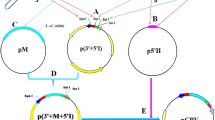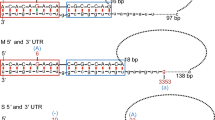Abstract
Feline panleukopenia virus (FPV) infects cats and can be fatal to kittens. There is evidence that canine parvovirus originated from FPV, which makes FPV important in studies of the family Parvoviridae. In the present study, the entire genome of FPV strain HH-1/86 was converted into a full-length infectious clone (pFPV). The FPV strain HH-1/86 has a 5123-nt single stranded DNA genome with a Y-shaped inverted 3′ terminal repeat (ITR) and a U-shaped inverted 5′ ITR. Feline kidney cells (F81) were transfected with the pFPV clone which contained a genetic marker, and a rescued virus was obtained (rFPV). The rFPV was identified by its cytopathic effects, indirect immunofluorescence, growth curve analysis, western blot assay and hemagglutination, and was indistinguishable from the parent virus. The FPV infectious clone will facilitate the study of pathogenicity and viral replication of FPV and the inter-species transmission of parvoviruses.



Similar content being viewed by others
References
Stuetzer B, Hartmann K (2014) Feline parvovirus infection and associated diseases. Vet J 201(2):150–155. https://doi.org/10.1016/j.tvjl.2014.05.027
Race RE, Bloom ME, Coe JE (1983) Demonstration of Aleutian disease virus-specific lymphocyte response in mink with progressive Aleutian disease: comparison of sapphire and pastel mink infected with different virus strains. J Immunol 131(3):1558–1564
Davidson WR, Appel MJ, Doster GL, Baker OE, Brown JF (1992) Diseases and parasites of red foxes, gray foxes, and coyotes from commercial sources selling to fox-chasing enclosures. J Wildl Dis 28(4):581–589. https://doi.org/10.7589/0090-3558-28.4.581
Decaro N, Desario C, Miccolupo A, Campolo M, Parisi A, Martella V, Amorisco F, Lucente MS, Lavazza A, Buonavoglia C (2008) Genetic analysis of feline panleukopenia viruses from cats with gastroenteritis. J Gen Virol 89(Pt 9):2290–2298. https://doi.org/10.1099/vir.0.2008/001503-0
Christensen J, Tattersall P (2002) Parvovirus initiator protein NS1 and RPA coordinate replication fork progression in a reconstituted DNA replication system. J Virol 76(13):6518–6531
Faisst S, Perros M, Deleu L, Spruyt N, Rommelaere J (1994) Mapping of upstream regulatory elements in the P4 promoter of parvovirus minute virus of mice. Virology 202(1):466–470. https://doi.org/10.1006/viro.1994.1363
Garcin P, Cohen S, Terpstra S, Kelly I, Foster LJ, Pante N (2013) Proteomic analysis identifies a novel function for galectin-3 in the cell entry of parvovirus. J Proteom 79:123–132. https://doi.org/10.1016/j.jprot.2012.12.010
Chapman MS, Rossmann MG (1993) Structure, sequence, and function correlations among parvoviruses. Virology 194(2):491–508. https://doi.org/10.1006/viro.1993.1288
Barker IK, Povey RC, Voigt DR (1983) Response of mink, skunk, red fox and raccoon to inoculation with mink virus enteritis, feline panleukopenia and canine parvovirus and prevalence of antibody to parvovirus in wild carnivores in Ontario. Can J Comp Med 47(2):188–197
Hueffer K, Parrish CR (2003) Parvovirus host range, cell tropism and evolution. Curr Opin Microbiol 6(4):392–398
Carlson J, Rushlow K, Maxwell I, Maxwell F, Winston S, Hahn W (1985) Cloning and sequence of DNA encoding structural proteins of the autonomous parvovirus feline panleukopenia virus. J Virol 55(3):574–582
Martyn JC, Davidson BE, Studdert MJ (1990) Nucleotide sequence of feline panleukopenia virus: comparison with canine parvovirus identifies host-specific differences. J Gen Virol 71(pt11):2747–2753. https://doi.org/10.1099/0022-1317-71-11-2747
Parrish CR, Carmichael LE (1983) Antigenic structure and variation of canine parvovirus type-2, feline panleukopenia virus, and mink enteritis virus. Virology 129(2):401–414
Cotmore SF, Agbandje-McKenna M, Chiorini JA, Mukha DV, Pintel DJ, Qiu J, Soderlund-Venermo M, Tattersall P, Tijssen P, Gatherer D, Davison AJ (2014) The family Parvoviridae. Arch Virol 159(5):1239–1247. https://doi.org/10.1007/s00705-013-1914-1
Wang F, Wei Y, Zhu C, Huang X, Xu Y, Yu L, Yu X (2010) Novel parvovirus sublineage in the family of Parvoviridae. Virus Genes 41(2):305–308. https://doi.org/10.1007/s11262-010-0506-3
Steinel A, Venter EH, Van Vuuren M, Parrish CR, Truyen U (1998) Antigenic and genetic analysis of canine parvoviruses in Southern Africa. Onderstepoort J Vet Res 65(4):239–242
Hong C, Decaro N, Desario C, Tanner P, Pardo MC, Sanchez S, Buonavoglia C, Saliki JT (2007) Occurrence of canine parvovirus type 2c in the United States. J Vet Diagn Investig 19(5):535–539. https://doi.org/10.1177/104063870701900512
Nakamura M, Tohya Y, Miyazawa T, Mochizuki M, Phung HT, Nguyen NH, Huynh LM, Nguyen LT, Nguyen PN, Nguyen PV, Nguyen NP, Akashi H (2004) A novel antigenic variant of canine parvovirus from a Vietnamese dog. Arch Virol 149(11):2261–2269. https://doi.org/10.1007/s00705-004-0367-y
Shackelton LA, Parrish CR, Truyen U, Holmes EC (2005) High rate of viral evolution associated with the emergence of carnivore parvovirus. Proc Natl Acad Sci USA 102(2):379–384. https://doi.org/10.1073/pnas.0406765102
Truyen U, Evermann JF, Vieler E, Parrish CR (1996) Evolution of canine parvovirus involved loss and gain of feline host range. Virology 215(2):186–189. https://doi.org/10.1006/viro.1996.0021
Hueffer K, Truyen U, Parrish CR (2004) Evolution and host variation of the canine parvovirus: molecular basis for the development of a new virus. Berliner und Münchener Tierärztliche Wochenschrift 117(3–4):130–135
Li G, Cai B, Zhang Z (1985) Isolation and identification of feline panleukopenia virus. Chin J Virol 1985(1–4):349–354
Yang S, Wang S, Feng H, Zeng L, Xia Z, Zhang R, Zou X, Wang C, Liu Q, Xia X (2010) Isolation and characterization of feline panleukopenia virus from a diarrheic monkey. Vet Microbiol 143(2–4):155–159. https://doi.org/10.1016/j.vetmic.2009.11.023
Zhu B, Cai G, Hall EO, Freeman GJ (2007) In-fusion assembly: seamless engineering of multidomain fusion proteins, modular vectors, and mutations. Biotechniques 43(3):354–359
Garigliany M, Gilliaux G, Jolly S, Casanova T, Bayrou C, Gommeren K, Fett T, Mauroy A, Levy E, Cassart D, Peeters D, Poncelet L, Desmecht D (2016) Feline panleukopenia virus in cerebral neurons of young and adult cats. BMC Vet Res 12:28. https://doi.org/10.1186/s12917-016-0657-0
Ikeda Y, Nakamura K, Miyazawa T, Takahashi E, Mochizuki M (2002) Feline host range of canine parvovirus: recent emergence of new antigenic types in cats. Emerg Infect Dis 8(4):341–346. https://doi.org/10.3201/eid0804.010228
Chang SF, Sgro JY, Parrish CR (1992) Multiple amino acids in the capsid structure of canine parvovirus co-ordinately determine the canine host range and specific antigenic and hemagglutination properties. J Virol 66(12):6858–6867
Parrish CR, Aquadro CF, Carmichael LE (1988) Canine host range and a specific epitope map along with variant sequences in the capsid protein gene of canine parvovirus and related feline, mink, and raccoon parvoviruses. Virology 166(2):293–307
Steinel A, Munson L, van Vuuren M, Truyen U (2000) Genetic characterization of feline parvovirus sequences from various carnivores. J Gen Virol 81(Pt 2):345–350. https://doi.org/10.1099/0022-1317-81-2-345
Bloom ME, Alexandersen S, Garon CF, Mori S, Wei W, Perryman S, Wolfinbarger JB (1990) Nucleotide sequence of the 5′-terminal palindrome of Aleutian mink disease parvovirus and construction of an infectious molecular clone. J Virol 64(7):3551–3556
Yuan D, Wang J, Li Z, Mao Y, Sun JZ, Xi J, Wang S, Hou Q, Yi B, Liu W (2014) Establishment of a rescue system for an autonomous parvovirus mink enteritis virus. Virus Res 183:1–5. https://doi.org/10.1016/j.virusres.2014.01.012
Kariatsumari T, Horiuchi M, Hama E, Yaguchi K, Ishigurio N, Goto H, Shinagawa M (1991) Construction and nucleotide sequence analysis of an infectious DNA clone of the autonomous parvovirus, mink enteritis virus. J Gen Virol 72(4):867–875. https://doi.org/10.1099/0022-1317-72-4-867
Han SC, Guo HC, Sun SQ, Shu L, Wei YQ, Sun DH, Cao SZ, Peng GN, Liu XT (2015) Full-length genomic characterizations of two canine parvoviruses prevalent in Northwest China. Arch Microbiol 197(4):621–626. https://doi.org/10.1007/s00203-015-1093-4
Maxwell IH, Chapman JT, Scherrer LC, Spitzer AL, Leptihn S, Maxwell F, Corsini JA (2001) Expansion of tropism of a feline parvovirus to target a human tumor cell line by display of an αv integrin binding peptide on the capsid. Gene Ther 8(4):324–331. https://doi.org/10.1038/sj.gt.3301399
Iseki H, Shimizukawa R, Sugiyama F, Kunita S, Iwama A, Onodera M, Nakauchi H, Yagami K (2005) Parvovirus non-structural proteins induce an epigenetic modification through histone acetylation in host genes and revert tumor malignancy to benignancy. J Virol 79(14):8886–8893. https://doi.org/10.1128/JVI.79.14.8886-8893.2005
Acknowledgements
This work was supported in part by the National Key Research and Development Program of China (No. 2016YFD0501004).
Funding
Funding was provided by National Natural Science Foundation of Jilin Province and Public Welfare (Agricultural) Industry Research Special Program.
Author information
Authors and Affiliations
Contributions
SY, YZ and WL conceived and designed the experiments. NC and WZ performed the experiments. JX, YY, HW, YG, and XX analyzed the data. NC and WZ wrote the article. GL managed and submitted the paper.
Corresponding authors
Ethics declarations
Conflict of interest
The authors do not have any conflicts of interest.
Ethical approval
This study was carried out in accordance with the recommendations in the Guide for the Care and Use of Laboratory Animals developed by the China Council on Animal Care. All protocols were approved by the Committee on the Ethics of Animal Experiments of the Institute of Military Veterinary at the Academy of Military Medical Sciences. The approved ID or permit numbers were SCXK-2012-017.
Additional information
Edited by Zhen Fu.
Rights and permissions
About this article
Cite this article
Cheng, N., Zhao, Y., Han, Q. et al. Development of a reverse genetics system for a feline panleukopenia virus. Virus Genes 55, 95–103 (2019). https://doi.org/10.1007/s11262-018-1621-9
Received:
Accepted:
Published:
Issue Date:
DOI: https://doi.org/10.1007/s11262-018-1621-9




